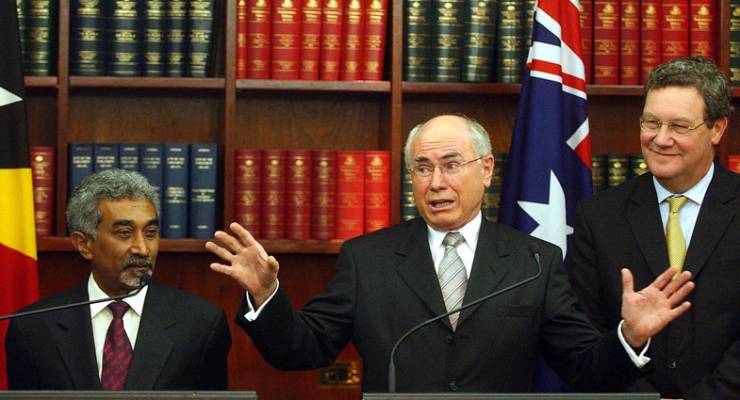
East Timor Prime Minister Mari Alkatiri, Australian Prime Minister John Howard and Australian Foreign Minister Alexander Downer after signing the treaty in 2006
East Timor has won a significant moral victory in the Timor Sea dispute, with Australia agreeing to scrap the controversial 2006 Timor Sea treaty. However, East Timor’s hope that this now spells the beginning of the end of that dispute, much less that it will secure the country’s economic future, might be overly optimistic.
The agreement to scrap the treaty effectively confirms East Timor’s claim that Australia acted in bad faith while negotiating the 2006 Certain Maritime Arrangement in the Timor Sea (CMATS) Treaty by spying on East Timor cabinet treaty discussions in 2004. Australia initially argued that the UN’s Conciliation Commission of the Permanent Court of Arbitration (PCA) did not have jurisdiction to hear the case on the 2006 treaty, which the PCA ruled against, so scrapping the treaty represents a humiliating defeat for Australia.
In a further apparent victory for East Timor, Australia has agreed to negotiate a permanent maritime boundary between the two countries under the auspices of the PCA. East Timorese officials say finalising the maritime boundary will offer certainty to oil and gas investors.
East Timor’s claim to a permanent boundary equidistant between the two countries would put all of the Timor Sea oil reserves and, it claims, its gas reserves, under East Timorese sovereignty. The claim to the gas reserves will be dependent on where the lateral boundaries are drawn, which will also require Indonesia to agree to modify its own boundaries.
[Our land is girt by oil-rich sea … that we steal from East Timor]
While East Timorese officials now say that ending the 2006 treaty means the way is open for the country to secure its economic future, there is no timeframe for negotiations, and the agreement does not indicate where the new boundaries might be. The Australian government could seek a negotiated settlement that compromises the equidistant sea boundary or the allocation of resources within it.
The statement that ends the 2006 treaty simply says that the two countries “agreed to an integrated series of measures intended to facilitate the conciliation process and create conditions conducive to the achievement of an agreement on the permanent maritime boundaries in the Timor Sea”.
In part, Australia has little to lose by now giving way to East Timor’s claims, as revenues from oil in the Timor Sea will be exhausted within the next few years. The greater financial prize is the Greater Sunrise liquid natural gas (LNG) field, just under 20% of which lies within the area under agreement between Australia and East Timor.
Australia had agreed to split 50-50 the revenue from the Greater Sunrise LNG field. Initially, East Timor accepted this proposition on the condition that the LNG be processed on East Timor’s south coast. The intention was that this south coast refining facility would kick-start a petro-chemical industry in East Timor that would sustain the country after both oil and gas ran out.
However, the Greater Sunrise development partner, Woodside Petroleum, balked at refining the LNG in East Timor. It noted the difficulty of laying a pipeline across the 3300-metre-deep Timor Trough and that East Timor did not have the material or human resources necessary to undertake refining. Given the bitterness of the subsequent dispute, the question of “sovereign risk” of the multibillion-dollar investment has also been raised.
[East Timor is mad as hell, and it’s our fault]
At the peak of LNG prices in around 2013, the Greater Sunrise field was worth about US$45 billion to Australia and East Timor. However, since then world LNG prices have slumped. Woodside noted that the previous 2002 Timor Sea Treaty remained in place but did not indicate that it would accept onshore processing, and the company has previously proposed a floating processing platform option.
The scrapping of the 50-year treaty comes as East Timor’s government increasingly recognises the country’s economic insecurity. East Timor’s sovereign wealth “Petroleum” fund has around US$16 billion. The interest from this fund was intended to provide working capital for East Timor’s government. However, the East Timorese government has been spending both the interest and about a billion dollars a year in capital from the fund. With income from Timor Sea oil diminishing, at current rates of government expenditure, East Timor will be broke by the end of the 2020s.
Accessing funds from the Greater Sunrise field could stave off such a financial collapse. This, however, assumes the Greater Sunrise field will be developed by a partner willing to agree to East Timor’s onshore processing demands, or that East Timor will relinquish its claim to onshore processing.
The scrapping of the 2006 treaty is a first step towards East Timor securing its economic future. But it will need all future breaks to go its way if it is to avoid economic collapse.
* Damien Kingsbury is professor of international politics at Deakin University








Poor buggers. We’ve been huge bastards to them ever since Portugal walked away from them.